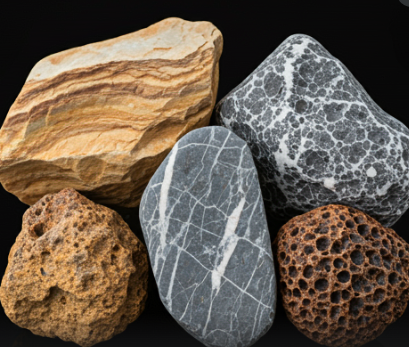
As a civil engineer, understanding the types of rocks present at a construction site is crucial. Rocks form the bedrock of our planet and significantly influence the engineering properties of soil and the stability of structures. This article explores the three primary rock types: igneous, sedimentary, and metamorphic, and how to identify them on-site.
Igneous Rocks
Igneous rocks are formed from the cooling and solidification of molten rock (magma or lava).
- Intrusive Igneous Rocks: These form when magma cools and solidifies slowly beneath the Earth’s surface. Examples include granite and diorite. They are characterized by large, interlocking crystals.
- Extrusive Igneous Rocks: These form when lava cools and solidifies rapidly on or near the Earth’s surface. Examples include basalt and pumice. They often have small, fine-grained crystals or a glassy texture.
Sedimentary Rocks
Sedimentary rocks are formed from the accumulation and consolidation of sediments, such as sand, mud, and organic matter.
- Clastic Sedimentary Rocks: These form from fragments of other rocks. Examples include sandstone, shale, and conglomerate. They often have layered structures.
- Chemical Sedimentary Rocks: These form from the precipitation of minerals from water. Examples include limestone and halite. They often have crystalline structures.
Metamorphic Rocks
Metamorphic rocks are formed from existing rocks that undergo changes in temperature, pressure, or chemical conditions.
- Foliated Metamorphic Rocks: These have a layered or banded appearance due to the alignment of mineral grains. Examples include slate, schist, and gneiss.
- Non-foliated Metamorphic Rocks: These do not have a layered appearance. Examples include marble and quartzite.
Identifying Rocks on-Site
Civil engineers can identify rock types on-site using a combination of visual inspection and simple tests:
- Visual Inspection:
- Color: Different rock types have distinct colors. For example, granite is often light-colored, while basalt is dark.
- Texture: The size and arrangement of mineral grains can help identify rock types.
- Structure: Look for layers, banding, or foliation in metamorphic rocks.
- Simple Tests: Hardness: Scratch the rock with a knife or coin to assess its hardness. Reaction to Acid: Some rocks, like limestone, react with acid, producing bubbles.
Understanding rock types is essential for civil engineers. By recognizing the characteristics of igneous, sedimentary, and metamorphic rocks, engineers can make informed decisions about foundation design, excavation methods, and material selection.
Leave a Reply